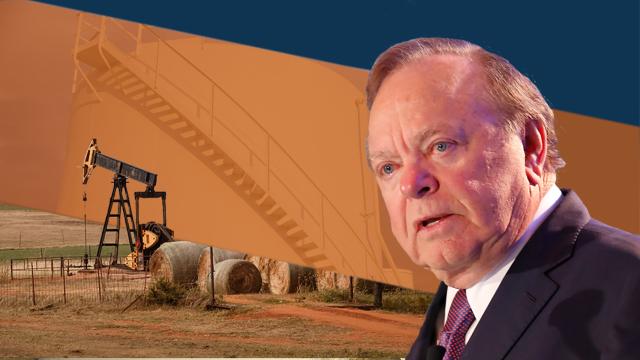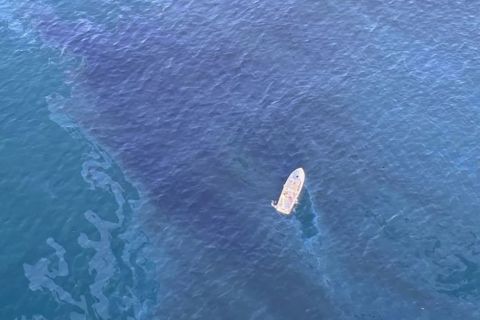
(Source: HartEnergy.com)
This coverage from DUG Midcontinent was updated at 3:02 p.m. You can also follow on Twitter at @HartEnergyConf.
OKLAHOMA CITY—Harold Hamm, iconic founder, chairman and CEO of Continental Resources Inc., declared that “the future’s bright” for Oklahoma oil and gas as he opened the DUG Midcontinent Conference on Nov. 20.
The state has balanced resources and more oil than previously thought, Hamm said, noting that “We have a good regulatory structure. We do need commodity prices to recover.”
DUG Midcontinent Day 2:
Oklahoma Operators Discuss Challenges, Innovation
Hamm also acknowledged that production of NGL exceeded what the market could handle.
“That will correct,” he said. “At present, it’s under a lot of pressure.”
Oversupply wouldn’t have been as bad, he said, “but we had a lot of elements from the market—basically private equity—and it overloaded the industry.”
Hamm also pointed to public capital as part of the issue, as well. Balancing of the market and discipline by producers are keys to a commodity price rebound, he said.
The Bakken, Hamm said, is the play that lit up energy for America. He pointed to its richness and resources, and middle distance to markets as the reason it became a game changer.
The quotable executive also discussed:
- Exports: “Without [OPEC] dumping oil in here we probably didn’t get [the export ban] reversed. Was it a gotcha moment for OPEC? Yeah, it was.”
- Politics: “Yes, there is a war on energy here. All you have to do watch the debates tonight.”
The industry, Hamm emphasized, is in “great shape” and he cited how the oil and gas sector has reduced emissions 15% since 2007.
“It takes energy,” he said, “to provide clean air and water.”
Wall Street Perspective
Inflated inventory counts fooled investors, said Mike Kelly, managing director and senior analyst for Seaport Global Securities LLC. That led to three failures related to well interference.
Investors focused too much on single well economics rather than full-field economic, Kelly said. They looked too deeply at early data rather than the 90-day and longer results.
Things have changed, though. Today, Kelly said, Wall Street has learned to dial back infill/child economics, the necessity of unspacing, well sequencing and distrusting IP-rates to find success with well intervention.
Operator Spotlight: Mississippi Lime
Kenneth Mariani, Amplify Energy Corp.’s president and CEO, said he’s averaging a 28-day period to clear a permit for offshore operations and over a year for permits in Wyoming.
“It’s hard to increase your stock value when you’re that tightly controlled,” Mariani said.
The industry doesn’t need a cleansing, it needs a consolidator,” he said.
The issue with Wall Street is that it “doesn’t trust the industry or the numbers, but you give them money, then they can get their arms around that,” Mariani said.
“Our share price since the merger was announced went up about 30%,” he said. “We do believe Wall Street understands our message: illuminate capital.”
Operator Spotlight: Arkoma Stack
Calyx Energy President and CEO Calvin Cahill said the company was drawn to the “neat” Arkoma Stack play because it consisted of more than 50% brittle reservoir rock, citing between 70% and 80% in his findings.
“We use offshore tools for drilling so we have real-time logs,” Cahill said, noting that it has advanced geosteering—the optimal placement of a wellbore—to stay in target zones, along with other heavy investments in seismic.
Cahill noted that Calyx has recycled over 7 million barrels of produced water in the last two years. In 2020, Cahill said the company plans to continue the development of the Mayes play in the second quarter, drilling Woodford inventory and hedging into improved pricing.
Full-Field Development Forum
The oil and gas industry is “in a full-blown liquidity crisis on top of our capital intensity issues,” Subash Chandra, managing director of Guggenheim Partners, said at the start of the DUG Midcontinent Full-Field Development Forum earlier on Nov. 20.
“The relationship between completion intensity and higher production has peaked over two to four years, and is becoming inverse,” Chandra said.
And trying to lock in on what investors want from oil and gas production and operations is complicated by how Wall Street changes its thinking on a quarterly basis, he said.
“Well interference has been the grenade in every earnings call,” Chandra said.
Panel: Overcoming Challenges
Richard Spears, vice president of Spears & Associates Inc., said that 14,000 wells will need to be drilled next year just to offset this year’s loss in production.
“This is the only year I’ve seen zero change but so much turmoil in that zero,” Spears said. He added that investors reward companies for being where the investors want it to be. The Midcontinent has just not had the love so you don’t get rewarded. That results in capital leaving.
Jason Baihly, commercial and risk manager for integrated services management at Schlumberger, said the Midcontinent posed unique challenges as far as parent/child wells, particularly in the area of seismic features of the play.
Baihly said a solid understanding of the faults, fissures, natural fractures and reservoir quality is necessary to succeed in the Midcontinent. He added that digital and operational solutions were being worked on.
Panel: Frac Sand
Beverly Suffern, vice president for commercial development at Black Mountain Sand, said regional sand has made its way to the Midcontinent because of changes in technology, particularly in slickwater frac designs. She added that demand for frac sand is expected to grow in 2020 but a lot of that growth is in the Permian Basin. Other plays are starting to decline.
Also on the panel, Erik Nystrom, vice president of strategic marketing for Covia Corp., said when it comes to sand supply chain, “everyone talks about last mile, but first- and mid-mile are important.”
Nystrom added that those are important whether a producer uses northern sand or in-basin sand.
Operator Fireside Chat
“I don’t know that we have a benchmark,” said Pat Bent, senior vice president for operations at Continental, in describing the company’s well spacing. “Results drive your next decision. You have to understand gas ratios and deliverability in making those decisions.”
He also noted that “there’s always room for any sized organization because sizes create economies of scale.”
Spotlight
In Oklahoma, two-thirds of the rigs have gone away yet the oil price remains the same.
“It almost defies logic,” said Michael Dunkel, global technology leader for upstream water at Advisian, part of the Worley Group.
Dunkel described Oklahoma seismicity as a success story.
“We’ve brought the number of earthquakes down without destroying industry,” he said. “We’ve done a good job working with regulators.”
Dunkel assured the crowd that sentiment improve and the rig count will come back to Oklahoma. Helping to drive the rebound will be water management and the growth of midstream.
Recommended Reading
Coast Guard Confirms Amplify’s Platform Elly Unrelated to California Oil Sheen
2024-03-11 - Amplify Energy remains confident that the sheen off Huntington Beach, California is not related to its operations.
US Coast Guard Investigating Oil Spill Off California Coast
2024-03-08 - The U.S. Coast Guard is responding to an oil spill off the coast of Huntington beach.
For Sale, Again: Oily Northern Midland’s HighPeak Energy
2024-03-08 - The E&P is looking to hitch a ride on heated, renewed Permian Basin M&A.
E&P Highlights: Feb. 26, 2024
2024-02-26 - Here’s a roundup of the latest E&P headlines, including interest in some projects changing hands and new contract awards.
Gibson, SOGDC to Develop Oil, Gas Facilities at Industrial Park in Malaysia
2024-02-14 - Sabah Oil & Gas Development Corp. says its collaboration with Gibson Shipbrokers will unlock energy availability for domestic and international markets.




